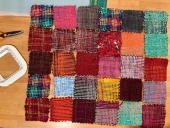





Eric Hanson wrote:Perhaps a sock could be made with different layers? Maybe a more durable outside layer and a more skin friendly inside layer? Naturally I am thinking about warm, winter socks as although I love winter and cold weather, my feet get cold easily.

Derek Thille wrote:
Timothy Norton wrote:
Perhaps there's another way of looking at things. Why socks? Are socks necessary? There are cultures where socks generally aren't worn. The giant hobbit at Wheaton Labs can often be seen outside barefoot (perhaps not in winter though). Are socks just a social construct to sell something? Where footwear is needed (say cold regions or perhaps rocky locales), is there a footwear type that can be used without socks? Just throwing it out for some perhaps outside the box pondering.
I suppose the primary purposes of socks are 1) warmth 2) prevent blisters 3) help manage foot moisture and 4) a washable layer between the foot and boot to keep them cleaner.
Knitting is a relatively modern technique, only several hundred to perhaps a thousand or so years old. Prior to that there was "single needle knitting" often known as naalbinding or several other spellings. Oldest known socks were made using that technique and are less than 2000 years old.
Another foot covering is known as Footwraps and were used by some Eastern European millitaries into the modern era (Russia had stopped but apparently started again with their current mobilization); also leg wraps sometimes referred to as Puttees.
I can attest, however, that wearing socks greatly improves how warm I feel when it's even a little cool (and I should really go put some on right now!)

